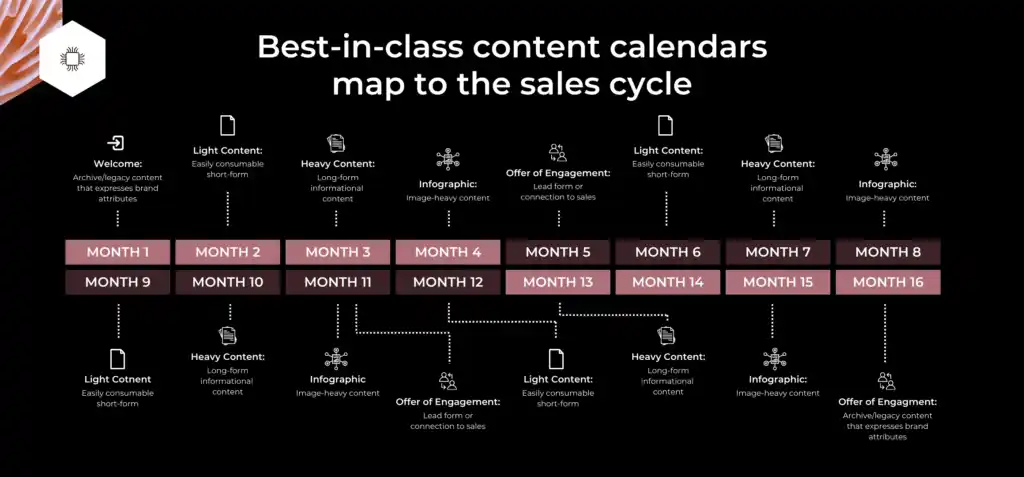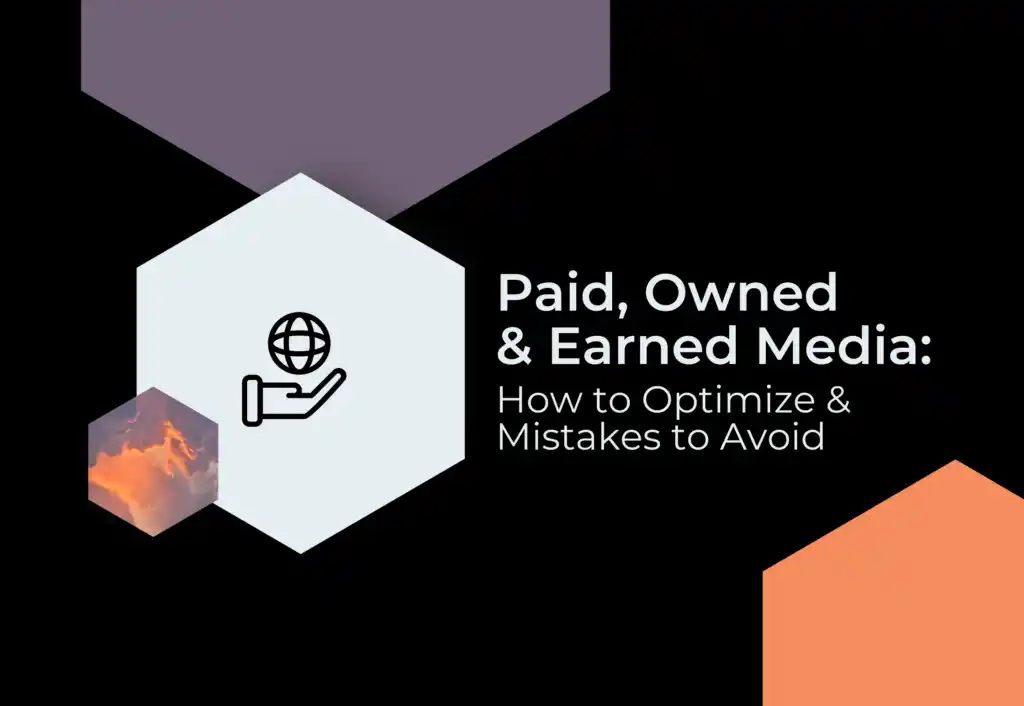
Every business and niche has to move customers/clients through the same basic stages:
- Unaware
- Aware
- Consideration
- Conversion
- Retention
- Loyalty
But unlike their eCommerce counterparts, lead generation for technology companies requires a different approach because these brands have to account for a much longer sales cycle.
Today, we’re sharing the data-driven strategic framework that Apiary has been using to provide B2B technology lead generation services for almost a decade.
Plus! We’re giving you free access to our ROI-Based B2B Performance Calculator, straight from the math-genius brain of our Director of Strategy & Business Impact.

What is lead generation?
B2B lead generation is the process of identifying and attracting ideal potential clients/customers. The goal is to turn interested prospects into highly qualified leads that can be handed over to the sales team, where those leads will convert into long-term customers.
Many B2B lead generation companies will say that you’ll get nowhere without paid ads, or it’s all about PR and brand authority, but we’re partial to the “Kitchen Sink of Marketing” approach. You need it all.
Overreliance on one channel or tactic will spell DISAPPOINTMENT in no time.
Sustainable and high-performing B2B lead generation requires establishing and maintaining a set of data-driven practices and foundational elements that maximize time, talent, and effort.
Let’s explore the essential elements of B2B lead generation for software companies:
The 10 steps to successful B2B lead generation
The one-size-fits-all approach to marketing has never been our jam. Your goals, context, and market opportunities are distinctly yours, which is why we build a customized lead generation system for every client-partner.
Generally, the best performing (and lasting!) B2B lead generation programs all take a data-driven approach to the following:
- ROI-based budget
- User persona(s)
- User journey
- Website/UX
- Martech stack
- Content marketing
- Nurture flows
- Lead scoring
- Paid media
- ROI measurement
1. ROI-based budget
Lead gen budgets can be crafted in one of two ways:
Option #1: “Here’s the amount we have to spend. How many leads can I drive with that?”
Option #2: “I need to drive X leads. What does my budget need to be to achieve that, given the Total Addressable Market?”
While we’re starting our list with an ROI-centric budget, this item can actually occur anywhere in the process. However, if a brand chooses Option #2, budget creation can only happen once the Total Addressable Market has been precisely defined.

2. User persona(s)
Persona development refers to the creation of detailed audience profiles that provide a nuanced understanding of the customer’s motivations and preferences, which leads to:
- Improved lead quality, thereby increasing the likelihood of conversion
- Messaging that resonates with the target audience’s needs and pain points
- More precise understanding of the segments within the overall audience, which can be leveraged with strategies and content tailored for their unique segment qualities
- Allocating budget based on verifiable data
- Data-confirmed tactical decisions (e.g. Would this persona be more/less likely to engage with a brand that offers free trials or freemiums?)
Defining a data-verified user persona MUST happen in tandem with the definition of the Total Addressable Market (TAM). Fairly custom for every brand, TAM represents the maximum achievable sales potential for your product/service.
3. User journey
With defined personas, the next step is dialing in your understanding of each persona’s journey through the buying process. This is where we see the biggest divergence between eCommerce and B2B marketing: the length of the sales cycle.
For eCommerce brands, the goal is to get users to your website and motivate them to convert immediately. In the B2B world, that conversion journey can take anywhere from 3-12 months. We’ve seen tech programs with two-year sales cycles.
This presents B2B brands with the unique challenge of continually engaging leads for an extended period of time.
Research by Marketo found that it typically takes 7-13 or more touchpoints to convert a B2B buyer, depending on the complexity of the product or service being sold.
This circles right back to why persona development is crucial. We need precise information on the target audience in order to provide the most relevant journey down the funnel.
The cadence of the engagement, channels used, and the content of each touchpoint, are all equally important.
4. Website/UX
Every customer journey includes a series of interactions with your website. Without the brick and mortar of a physical location, your website is the digital home you welcome guests into.
- When they first become aware of you, they visit your site.
- While they’re learning more about your offering, they’re visiting your site.
- As they move towards a purchasing decision, they’re on your site again.
Layering the stages of the user journey onto a consideration of how customers need to use your website is critical to sales success.
Additionally, preparing your site with the right user experience, content, and technical set up moves prospective customers more efficiently through the funnel, creating funnel velocity.
Every marketing activity you engage in (content marketing creation, investing in SEO, leveraging paid advertising, etc) is making a promise about your brand. To fulfill that promise, your website needs to understand what a prospect needs and be prepared to offer it.
5. Martech stack
To continually engage with multiple leads over a 3 to 12-month period (or longer) and accurately track the data coming out of each of those touchpoints requires more than standard CRM (Customer Relationship Management) settings.
B2B tech brands need a stack of marketing technology tools automating and monitoring this complex process, which allows you to:
- Automate repetitive tasks, streamline workflows, and improve collaboration among teams
- Deliver a more seamless and personalized customer experience across multiple touchpoints, improving customer satisfaction and loyalty.
- Deepen insights through more comprehensive data analysis, which leads to optimizations that are more likely to drive performance improvements
- Quickly adapt to changes in the market and customer behavior, and test new strategies and tactics more easily.
The right martech tools allow you to make the most of the user segmentation you did in Steps 2 and 3 above. Even if there’s a ton of overlap between them, different personas need to receive different content in a different sequence or format, which leads us to…
6. Content marketing
Here’s the most concise we can be about B2B content marketing:

While qualitative data certainly has its place, our Apiary philosophy is to put quantitative data at the center of everything and build from there.
8 common mistakes in B2B content marketing:
- The effectiveness of your content (format, distribution channels, distribution cadence) has not been verified by reliable data sources.
- There’s no well-defined content marketing strategy in place, or the “strategy” doesn’t align with business goals and target audience needs
- Focusing too heavily on product-centric content, which the prospect experiences as an excessive sales pitch that’s often alienating.
- Insufficient audience research (What are their preferences, obvious and less obvious pain points, and interests?).
- Inconsistent content creation and publishing, which misses the opportunity to keep the audience engaged and increase brand credibility and SEO domain authority.
- Content is poorly optimized for relevant keywords and on-page SEO elements that could be driving more organic (aka: much cheaper) visibility.
- Insufficient effort and resources invested in distributing content across multiple channels, including engaging with influencers and industry publications (earned media).
- Failing to measure the performance and impact of content marketing efforts diminishes your ability to make data-driven optimizations.
The ideal B2B content marketing cadence
Gary Vaynerchuk’s “Jab, Jab, Jab, Right Hook” analogy is a helpful way of thinking about the best practices for your content marketing cadence.
Begin with educational and engagement-inducing touchpoints that don’t directly ask the lead for anything. The purpose of these ‘jabs’ is to build trust, establish your brand as a singular thought leader in your niche, and provide information that encourages the lead to keep moving through the funnel.
At the right interval, the right hook arrives in the form of an engagement offer, lead form, or sales call CTA.
As Mistake #3 mentioned above, if the ratio of right hooks to jabs is too high, this typically has a repelling effect. Nailing the cadence is crucial.
Best-in-class content cadence is 4X4. Four content types cycled four times over the course of the sales cycle.
For a B2B tech brand, here’s what the 4X4 cadence looks like, when mapped to a 16-month sales cycle:

7. Nurture flows
B2B brands often fall into the trap of categorizing all captured data as a “lead” and quickly transfer it to the sales team; a misstep that hinders effectiveness.
Every responder (person who communicates interest by raising their hand in some way) will not become a Marketing Qualified Lead (MQL), Sales Qualified Lead (SQL), or even an opportunity.
By overlooking this fact, many brands are asking for the sale far too early, which is akin to proposing marriage on the first date.
Even if they’re jonesin’ to walk down the aisle with you, large tech investments are rarely made without a lengthy courtship period. Don’t rush the courting!
Speed-dating your way into discussing nuptials is often experienced as desperation or pushy energy. Most leads turn away from a brand when they encounter this, and it also creates friction with the sales team because they’re being fed “leads” that are not ready to move into the conversion portion of the funnel.
So, what’s a B2B brand to do?
High performing lead gen requires a high degree of patience.
To keep prospects engaged and progressing through the (typically long) B2B tech sales funnel, and to assure them they’ll reap substantial rewards from investing in your brand, a meticulous lead nurture process is a must.
Nurture flows: A series of targeted and personalized communications designed to educate, build trust, and help potential customers move down the funnel.
Nurture flows, also known as lead nurturing campaigns, are commonly conducted via email, but social media, paid media, content, and events, can also be leveraged.
By delivering relevant and valuable content based on specific interests, behaviors, and stage in the buying cycle, nurture flows aim to build trust, establish thought leadership, address pain points, and guide leads into becoming qualified prospects or customers.
How is Lead Nurture different from Content Marketing?
Content marketing supports a prospect’s decision making generally, without requiring the prospect to share their contact information.
Lead nurture campaigns are a highly targeted deployment of content that’s delivered once a prospect has provided their contact information and somehow indicated where they are in the user journey.

Successful nurture flows are built on 5 core principles:
- Each lead is located in a distinct spot in the user journey, which is why applying a single nurture experience to all leads is a performance miss.
- Create opportunities for prospects to demonstrate their location in the funnel, so you have data that confirms exactly what to send them and when.
- The person receiving the nurture sequence is rarely the sole decision maker. Provide what they need to convince the influencers, stakeholders and other financial parties whose approval is required.
- The four-beat content sequence (see Step #6 above) works well here too, and supports the affirmation necessary for an organization to make a decision of this size.
- To successfully manage lead nurture, most brands need to implement modern marketing automation tools.
8. Lead scoring
Lead scoring refers to the process of assigning a numerical value to potential leads to indicate their level of interest and readiness for further engagement or sales outreach.
Important lead scoring questions for a brand to explore include:
- How do we distinguish between a raw responder (or contact) and a lead?
- What actions demonstrate intent and what numerical value corresponds to each action?
- What steps or number of steps does a lead need to take to become a Marketing Qualified Lead (MQL)?
- What steps or number of steps will turn an MQL into an SQL (Sales Qualified Lead)?
- What would cause an SQL’s lead score to be reduced, such that they’d revert to MQL?
- How frequently are we reassessing the lead scoring system to ensure its relevance?
Although B2B lead scoring has become popular, we often see a lack of team cohesion on how scores are implemented and updated, which significantly undermines the effectiveness of the system.
Team members frequently apply their own distinct criteria when choosing to assign points in scenarios like:
- Lead visited your website more than twice
- Lead completed a quiz or product calculator
- Lead submitted their contact information on X landing page versus Y landing page.
A unified approach is vital, but even with internal alignment on how to score leads, lead scoring alone doesn’t drive performance. A well-maintained lead scoring system that fully integrates with a martech stack delivering data-proven content according to a best-in-class content cadence… THAT drives performance.
9. Paid, earned, and owned media
Keep in mind that after the initial awareness touchpoint, many of the leads moving through the funnel will conduct their own research on you. This is why it’s crucial to keep your organic social media updated – your leads ARE looking.
Similarly, it’s important to prioritize SEO improvements so that your brand is featured on the first page of organic search results for key brand terms. This often requires a combination of technical SEO enhancements and SEO content creation.
In addition to organic media (referred to as owned media), earned media also needs attention. This includes media features, panel interviews or other speaking gigs, awards, or coverage in industry publications.
And then, of course, there’s paid media…

4 Rules of Paid, Owned & Earned Media Many brands overindex in one of these categories, instead of building a holistic marketing mix that activates your maximum revenue potential. Read on to fix that!
Strong Recommendation: Don’t invest in paid media without a customized marketing dashboard to effectively monitor performance & spend.
Marketing analytics tracks every step of the progression from raw responder to lead, to MQL, to SQL, to customer conversion, and should be measured against vertical benchmarks.
Paid media performance, like all marketing activity, is entirely measurable and predictable.
With historical data from your marketing dashboard, and the calculations outlined in your ROI-Based Performance Calculator, you’ll be able to reliably forecast what you’ll net from the paid media budget you’re willing to invest.
10. ROI measurement
Measuring your marketing return on investment (ROI) for B2B lead generation is crucial for assessing the effectiveness and profitability of marketing efforts.
Unfortunately, many B2B performance teams are siloed and unaware of their lack of alignment on a) which ROI metrics are top priority, and b) how and how often those metrics are monitored and optimized against.
ROI cohesion requires answering key questions like:
- Is ROI determined by AOV (Average Order Value) or LTV (Lifetime Value)?
- Is your brand in a growth or profitability phase?
- Are you capturing costs outside of out-of-pocket (OOP) media?
If all marketing teams and strategic plans are not synced around identical answers to the questions above, even if things appear to be ‘working’, they’re not.
ROI measurement misalignment is one of the most common performance breakdowns we see.
In the B2B space, 4:1 is generally considered a good ROI.
For example, if a brand’s AOV is $10,000, they should be prepared to spend up to $2,500 through the pipeline to close a sale (that’s not just paid media spend – that’s TOTAL cost for that customer).
If it costs $50 to get a raw responder who will convert through the deployment of targeted marketing content, this brand would need to net one sale from a pool of 50 responders to achieve a 4:1 ROI. Benchmarks vary, so 50 raw responders narrowed to marketing qualified leads (MQLs), narrowed to sales qualified leads (SQLs), narrowed to opportunities needs to result in one sale for the math to work.
Achieving a 4:1 ROI means that the revenue generated from those leads should be at least $10,000, covering the acquisition cost and generating a profitable return.
Marketing math tells us exactly what it’ll cost to acquire the ROI/revenue numbers you need.

TL;DR on B2B tech lead generation
- B2B tech lead generation is the process of acquiring net new customers within the context of the longer sales cycle of most B2B tech brands.
- Lead gen budgets can be built based on available marketing dollars OR reverse engineer budget numbers based on desired revenue.
- User persona development and user journey mapping is a crucial step in acquiring a data-verified understanding of your target audience.
- A B2B brand’s marketing technology stack (CRM system, automation platforms, analytics tools, email marketing software, etc) can make or break performance.
- Marketing content creation should always be informed by the measurement and analysis of performance metrics that have the highest relevance for a brand’s unique context.
- The ideal content cadence is 4X4 – four types of content cycled four times over the course of the sales cycle.
- Lead scoring is a mechanism for quantifying the quality and potential of leads based on predetermined criteria and actions.
- Successful lead generation requires a holistic strategy that considers paid, earned, and owned media.
- In the B2B landscape, an ROI of 4:1 is generally considered good. It’s important that all marketing teams are aligned on which metrics confirm ROI.

